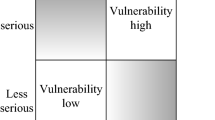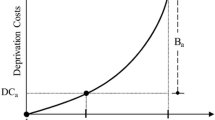Abstract
Traditionally, an assessment of transport network vulnerability is a computationally intensive operation. This article proposes a sensitivity analysis-based approach to improve computational efficiency and allow for large-scale applications of road network vulnerability analysis. Various vulnerability measures can be used with the proposed method. For illustrative purposes, this article adopts the relative accessibility index (AI), which follows the Hansen integral index, as the network vulnerability measure for evaluating the socio-economic effects of link (or road segment) capacity degradation or closure. Critical links are ranked according to the differences in the AIs between normal and degraded networks. The proposed method only requires a single computation of the network equilibrium problem. The proposed technique significantly reduces computational burden and memory storage requirements compared with the traditional approach. The road networks of the Sioux Falls city and the Bangkok metropolitan area are used to demonstrate the applicability and efficiency of the proposed method. Network manager(s) or transport planner(s) can use this approach as a decision support tool for identifying critical links in road networks. By improving these critical links or constructing new bypass roads (or parallel paths) to increase capacity redundancy, the overall vulnerability of the networks can be reduced.







Similar content being viewed by others
References
Asakura, Y., Kashiwadani, M.: Road network reliability caused by daily fluctuation of traffic flow. Eur. Transp. Highw. Plan. 19, 73–84 (1991)
Bell, M.G.H., Iida, Y.: Transportation Network Analysis. Wiley, Chichester (1997)
Berdica, K.: An introduction to road vulnerability: what has been done, is done and should be done. Transp. Policy 9(2), 117–127 (2002)
Berdica, K., Mattsson, L.: Vulnerability: a model-based case study of the road network in Stockholm. In: Murray, A.T., Grubesic, T.H. (eds.) Critical infrastructure: reliability and vulnerability, pp. 81–106. Springer, Heidelberg (2007)
Chen, A., Yang, H., Lo, H.K., Tang, W.H.: Capacity reliability of a road network: an assessment methodology and numerical results. Transp. Res. B 36(3), 225–252 (2002)
Clark, S.D., Watling, D.P.: Sensitivity analysis of the probit-based stochastic user equilibrium assignment model. Transp. Res. B 36(7), 617–635 (2002)
Connors, R.D., Sumalee, A., Watling, D.P.: Sensitivity analysis of the variable demand probit stochastic user equilibrium with multiple user-classes. Transp. Res. B 41(6), 593–615 (2007)
D’Este, G.M., Taylor, M.A.P.: Network vulnerability: an approach to reliability analysis at the level of national strategic transport networks. In: Bell, M.G.H., Iida, Y. (eds.) The Network Reliability of Transport, pp. 23–44. Pergamon, Oxford (2003)
Daganzo, C.F., Sheffi, Y.: On stochastic models of traffic assignment. Transp. Sci. 11(3), 253–274 (1977)
DOPA: Department of provincial administration, population statistics (in Thai). http://www.dopa.go.th/stat/y_stat51.html (2009)
Hansen, W.G.: How accessibility shapes land use. J. Am. Inst. Plan. 25(2), 73–76 (1959)
Jenelius, E.: Network structure and travel patterns: explaining the geographical disparities of road network vulnerability. J. Transp. Geogr. 17(3), 234–244 (2009)
MathWorks (2011) Matlab R2011a
Pearson, K.: Notes on the history of correlation. Biometrika 13(1), 25–45 (1920)
Robinson, S.M.: Strong regularity and the sensitivity analysis of traffic equilibria: a comment. Transp. Sci. 40(4), 540–542 (2006). doi:10.1287/trsc.1060.0162
Sheffi, Y.: Urban transportation networks: equilibrium analysis with mathematical programming methods. Prentice-Hall, Upper Saddle River (1985)
Spearman, C.: The proof and measurement of association between two things. Am. J. Psychol. 15(1), 72–101 (1904)
Sumalee, A., Luathep, P., Lam, W.H.K., Connors, R.D.: Evaluation and design of transport network capacity under demand uncertainty. Transp. Res. Rec. J. Transp. Res. Board 2090, 17–28 (2009)
Suwansirikul, C., Friesz, T.L., Tobin, R.L.: Equilibrium decomposed optimization: a heuristic for the continuous equilibrium network design problems. Transp. Sci. 21(4), 254–263 (1987)
Taylor, M.A.P.: Critical transport infrastructure in urban areas: Impacts of traffic incidents assessed using accessibility-based network vulnerability analysis. Growth Change 39(4), 593–616 (2008)
Taylor, M.A.P., D’Este, G.M.: Transport network vulnerability: a method for diagnosis of critical locations in transport infrastructure systems. In: Murray, A.T., Grubesic, T.H. (eds.) Critical Infrastructure: Reliability and Vulnerability, pp. 9–30. Springer, Heidelberg (2007)
Taylor, M.A.P., Sekhar, S.V.C., D’Este, G.M.: Application of accessibility based methods for vulnerability analysis of strategic road networks. Netw. Spatial Econ. 6(3), 267–291 (2006)
Van Vliet, D., Wright, I.: Saturn 10.6 user manual. The Institute for Transport Studies. The University of Leeds and Atkins Planning Consultants Ltd., Leeds (2006)
Wakabayashi, H., Iida, Y.: Upper and lower bounds of terminal reliability of road networks: an efficient method with boolean algebra. J. Nat. Disaster Sci. 14(1), 29–44 (1992)
Yang, H.: Sensitivity analysis for the elastic-demand network equilibrium problem with applications. Transp. Res. B 31(1), 55–70 (1997)
Yang, H., Sasaki, T., Iida, Y., Asakura, Y.: Estimation of origin-destination matrices from link traffic counts on congested networks. Transp. Res. B 26(6), 417–434 (1992)
Ying, J.Q., Miyagi, T.: Sensitivity analysis for stochastic user equilibrium network flows-a dual approach. Transp. Sci. 35(2), 124–133 (2001). doi:10.1287/trsc.35.2.124.10137
Acknowledgments
The first author would like to thank the Hong Kong Polytechnic University for providing the postgraduate research studentship. The research is also supported by a General Research Fund project of the Hong Kong Research Grant Council (PolyU5290/09E).
Author information
Authors and Affiliations
Corresponding author
Appendix A
Appendix A
Since the Jacobian of the probit path choice probability vector with respect to the mean path cost vector (\( \nabla_{{{\mathbf{c}}^{w} }} {\mathbf{P}}^{w} \)) is symmetric, it is only necessary to determine the upper triangular elements of \( \nabla_{{{\mathbf{c}}^{w} }} {\mathbf{P}}^{w} \) by using an approximation method (Clark and Watling, 2002).
For route k connecting the OD movement w, the derivative of the path choice probability (\( P_{k}^{w} \)) with respect to the cost on an alternative route j (\( C_{j}^{w}\)), at a given mean path cost vector \( {\mathbf{c}}^{w} \) with a variance–covariance matrix \( \varvec{\Upsigma}^{w} \), is formulated as
where \( {\mathbf{K}}^{w} \) is the subset of paths connecting the OD movement w; \( {\text{MNP}}_{k} \left( {{\mathbf{c}}^{w} \left( {k,j} \right),\varvec{\Upsigma}^{w} \left( {k,j} \right)} \right) \) is the multinomial probit (MNP) choice probability for alternative \( k \in {\mathbf{K}}^{w} \) corresponding to a model with N w − 1 alternatives (where the original model had \( N^{w} = \left| {{\mathbf{K}}^{w} } \right| \) alternatives), mean cost vector \( {\mathbf{c}}^{w} \left( {k,j} \right) \) and covariance matrix \( \varvec{\Upsigma}^{w} \left( {k,j} \right) \); and the matrix \( \varvec{\Upsigma}^{w} \left( {k,j} \right) \), row-vector \( {\mathbf{c}}^{w} \left( {k,j} \right) \), and scalar \( A\left( {k,j} \right) \) are computed from the following steps (with \( {\mathbf{c}}^{w} \) assumed to be in row-vector notation):
- Step 1: :
-
Calculate the inverse covariance matrix \( \left( {\varvec{\Upsigma}^{w} } \right)^{ - 1} \) and the row vector \( {\mathbf{c}}^{w} \cdot \left( {\varvec{\Upsigma}^{w} } \right)^{ - 1} \).
- Step 2::
-
Form the (N w − 1)-square matrix \( {\mathbf{D}}\left( {k,j} \right) \) from \( \left( {\varvec{\Upsigma}^{w} } \right)^{ - 1} \) by:
(2.1) adding row j of \( \left( {\varvec{\Upsigma}^{w} } \right)^{ - 1} \) to row k;
(2.2) adding column j of the resultant matrix from (2.1) to its column k;
(2.3) deleting row j and column j of the resultant matrix from (2.2).
- Step 3::
-
Form the (N w − 1) dimensional row vector \( {\mathbf{d}}\left( {k,j} \right) \) from \( {\mathbf{c}}^{w} \cdot \left( {\varvec{\Upsigma}^{w} } \right)^{ - 1} \), by adding the jth element to the kth element, and then deleting the jth element.
- Step 4::
-
Compute:
$$ \begin{aligned}\varvec{\Upsigma}^{w} \left( {k,j} \right) = \left( {{\mathbf{D}}\left( {k,j} \right)} \right)^{ - 1} , \\ {\mathbf{c}}^{w} \left( {k,j} \right) = {\mathbf{d}}\left( {k,j} \right) \cdot\varvec{\Upsigma}^{w} \left( {k,j} \right),\;{\text{and}} \\ A\left( {k,j} \right) = {\mathbf{d}}\left( {k,j} \right) \cdot\varvec{\Upsigma}^{w} \left( {k,j} \right) \cdot \left( {{\mathbf{d}}\left( {k,j} \right)} \right)^{T} - {\mathbf{c}}^{w} \cdot \left( {\varvec{\Upsigma}^{w} } \right)^{ - 1} \cdot\,\left( {{\mathbf{c}}^{w} } \right)^{T} \\ \end{aligned} $$
Since the Jacobian is symmetry and the choice probabilities must sum to 1, once all the off-diagonal elements have been determined the diagonal terms can be calculated from:
This approximation method is feasible to apply for large scale networks, where \( {\text{MNP}}_{k} \left( {{\mathbf{c}}^{w} \left( {k,j} \right),\varvec{\Upsigma}^{w} \left( {k,j} \right)} \right) \) can be calculated by Monte Carlo methods.
Rights and permissions
About this article
Cite this article
Luathep, P., Sumalee, A., Ho, H.W. et al. Large-scale road network vulnerability analysis: a sensitivity analysis based approach. Transportation 38, 799–817 (2011). https://doi.org/10.1007/s11116-011-9350-0
Published:
Issue Date:
DOI: https://doi.org/10.1007/s11116-011-9350-0




